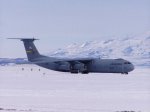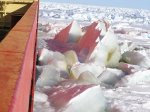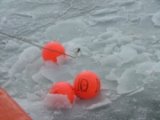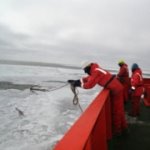In the Times of India (Goa Plus supplement)
This article along with a couple of pictures appeared in the Times of India (Goa Plus Supplement) on Friday, 16th December 2005.
--------------------------------------------------------------------------
A Goan in Antarctica
by Helga do Rosario Gomes
Novices in the intricate world of US scientific funding, my husband Joaquim Goes and I set out on what for us was a big adventure - a trip to Washington DC to attend a workshop on the US Antarctic Program and learn about the complex mechanisms that govern getting dollars out of the National Science Foundation (NSF), the biggest supporter of Antarctic research.
Little did we know that this trip would take us into a magical world of icebergs that resemble ruined castles, penguins that look you in the eye, 24 hours of blinding light, ice parties as well as the nastiest of storms and the most brutal of temperatures! With the largesse of the NSF we have just finished a three-year program where we along with scientists from five organizations in the USA, studied the impact of Ultraviolet radiation on marine biota in Antarctic waters.
In one of the biggest man-made ecological disasters ever, humans have pumped chemicals such as Chlorofluoro carbons used in refrigerants into the stratosphere destroying the blanket of ozone that envelopes our earth and absorbs harmful UV radiation. The largest of these ozone holes is located over the Antarctic. As a consequence people in the Southern hemisphere are at risk to skin cancers and the marine food chain in the Antarctic is susceptible to irreversible damage.
For three years we have taken the NSF's finest ice breaker, the Nathaniel Palmer to the Ross Sea, hacked through miles and miles of the thickest of ice and researched into various aspects of this problem - DNA damage from UV radiation, production of noxious green house gases, winds and turbulence and the loss of food to marine life. We visited McMurdo, the US base camp which in summer houses almost 2500 people and supports another camp much further south as well as a neutrino detector, the Ice Cube buried deep into the ice.
We watched from the library of the Crary lab, one of the most well equipped laboratories with a spectacular view of snow capped mountains, as helicopters constantly ferried scientists and engineers into the remotest of the Dry Valleys. And of course we spent time at the three bars, the one shop that has everything and even tried to get free haircuts! But most of all on a visit to British explorer Scott's almost intact hut, we had a glimpse into the world of courageous explorers whose passion for finding new worlds surpassed all else. With trappings of high technology we digitized their half eaten seals and sheep carcasses, tins of powered chocolate and biscuits, their clothes and tools.
Our return trip on a US Air Force plane was uncomfortable and we nearly lost our expensive equipment which almost got swallowed by ice floes. Everyday is an adventure.
Interested in more information?
Check out Helga's illustrated online diary (or blog) at http://goantoantarctica.blogspot.com.
Helga do Rosario Gomes and Joaquim Goes are researchers at the Bigelow Laboratory for Ocean Sciences in Maine, USA.















